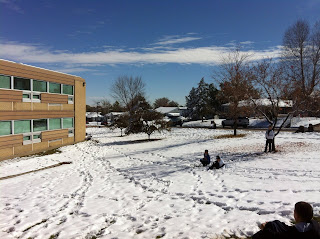Achieve Academy's 7th and 8th grade students record the seasonal changes of the Achieve Academy schoolyard.
Monday, December 5, 2011
Thinking about time
I am ready for a new way to experience time, especially this time of year. Instead of looking at a year in the traditional human sense, with months, days, and hours, this calendar looks at a year from the perspective of seasons-winter, spring, summer, fall-and the star position, sun position, moon position, ocean tides, and...you guessed it....phenological events.
You probably already know that I geek out about this stuff. So, I bought the calendar and was reading it this morning as I start to plan for 2012. I knew I made a good purchase when I got to the fourth page that starts out "It's All Connected." I will quote my new friend Hardman at length here to broaden our definition of phenology...it's good:
"Over the past several decades there has been a growing awareness of the interrelatedness of all things....This awareness has strongly influenced the study of ecology-the science of how living things interact with one another and their environment. Such interactions are affected by seasonally triggered events in nature.
Phenology, the study of timing of natural events, is an important component of ecology. Phenology was originally conceived to assist in successful planting of food crops and management of domesticated animals; phenological findings provided the information for framers' almanacs. More recently, phenology has expanded to include natural cycles on a broader scale, making the discipline an indispensable source of information for the ECOlogical Calendar."
So when we think about this new way to experience time, it is through nature's events based on the seasons, not the clock on my cell phone. I have a busy life and I find myself needing to know the exact minute of the day, what meeting I need to be in, where I need to go, and what I need to do. Instead, what if I thought about my week in comparison to where Jupiter is in the sky, which geese are migrating, and what the kangaroo rats are gathering? It's not as practical for my daily life, but it does remind me of what is happening in the world that I am connected to.
By the way: this week, Jupiter can be seen in the evening sky, the snow geese are migrating in large groups (100-1,000 birds) from Canada to the Gulf of Mexico (1,700 miles before resting!!!!), and the kangaroo rats are creating storage areas in the soil near their dens making sure that their winter food does not spoil in the wet/damp soil.
As you probably know, I had all of you in mind when I bought this calendar. I will be using Hardman's new perspective of time to add to our discussions on this blog.
Dr. Keena
Thursday, November 17, 2011
Hidden Treasures
We found an engravement under the tree above. The engraving said,"This tree is dedicated to Michael Hopkins Bertha Heid Elementary November 1, 1996."
Who do you think Michael Hopkins is?
Trivia of the week:
What percentage of energy do Americans waste?
Bonus Question:
What percentage of the world's population do Americans make up?
Saturday, November 5, 2011
Signs of Wildlife
A grasshopper hopped across Patricio's notebook.
Friday, November 4, 2011
swinging and journaling
The most exciting thing that happened was that Junior slipped and fell in the snow! (=.
We had a blast!!
Weird, True and Freaky: Achieve Academy
Drippy Days!
Friday, October 28, 2011
The Naked Trees
Nature Journaling in the Snow

EXXXXXXXXTRRRRRRREMEEEEEEEEEE Nature Journaling
 On Thursday, October 27 at around 1:00, Mr. Munden's homeroom went outside to nature journal! It was very snowy outside with 6 inches of snow with some bare patches of grass showing. It just snowed the night before, but it melted that day because the sun came out and it was like 1,000 degrees!
On Thursday, October 27 at around 1:00, Mr. Munden's homeroom went outside to nature journal! It was very snowy outside with 6 inches of snow with some bare patches of grass showing. It just snowed the night before, but it melted that day because the sun came out and it was like 1,000 degrees!Thursday, October 20, 2011
Feeding Barn Spider
On October 14, 2011, we went outside to explore and nature journal. While we were out there, Sandra, Giselle and Kevin spotted a barn spider in its orb web in one of the pine trees at the front of the school.
Mr. G came out with a cricket on his hand and put the cricket in the spider's web for him to eat. We observed that the moment the cricket hit the web the spider ran down, bit the cricket and began wrapping it in his web. Then the spider bit it again to kill it. Mr. G told us that the spider might not eat the cricket right away, he might wait to have it for dinner. When do you think the spider ate the cricket?
When we went outside on October 20, 2011, the spider web and the spider were no longer there. We predicted that the spider had to move closer to the tree trunk because of the cold, rainy weather.
What do you think happened to the spider and his web?
Do you still think the spider is alive?
How long do spiders live for?







